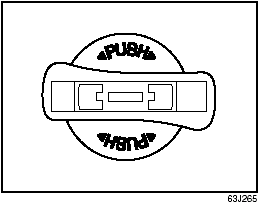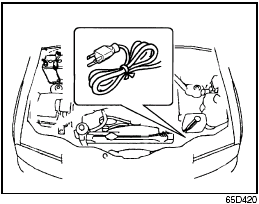Suzuki Grand Vitara: Starting the Engine
Before Starting the Engine
1) Make sure the parking brake is set fully. 2) Manual Transmission – Shift into “N” (Neutral) and depress the clutch pedal all the way to the floor. Hold it while starting the engine. Automatic Transmission – If the gearshift lever is not in “P” (Park) position, shift into “P”. (If you need to re-start the engine while the vehicle is moving, shift into “N”.)
NOTE: The engine of manual transmission vehicle will not start unless the clutch pedal is depressed.
NOTE: Automatic transmission vehicles have a starter interlock device which is designed to keep the starter from operating if the transmission is in any of the drive positions.
 WARNING: Make sure that the parking
brake is set fully and the transmission is in Neutral (or Park for vehicles with
an automatic transmission) before attempting to start the engine.
WARNING: Make sure that the parking
brake is set fully and the transmission is in Neutral (or Park for vehicles with
an automatic transmission) before attempting to start the engine.
Starting a Cold Engine
With your foot off the accelerator pedal, crank the engine by turning the ignition key to “START”. Release the key when the engine starts.
CAUTION:
• Stop turning the starter immediately after the engine has started or the starter
system can be damaged.
• Do not crank the engine for more than 15 seconds at a time. If the engine doesn’t
start on the first try, wait about 15 seconds before trying again.
If the engine does not start after 15 seconds of cranking, wait about 15 seconds, then press down the accelerator pedal to 1/3 of its travel and try cranking the engine again. Release the key and accelerator pedal when the engine starts. If the engine still does not start, try holding the accelerator pedal all the way to the floor while cranking. This should clear the engine if it is flooded. If you are unable to start the engine using this procedure, consult your SUZUKI dealer.
Starting a Warm Engine
Use the same procedure as for “Starting a Cold Engine”.

Vehicle With
Keyless Start System
The ignition switch can be operated when the remote controller is in the vehicle except the rear luggage area. To turn the ignition switch, push the switch first.
NOTE: You must push in the ignition switch to turn it from the “LOCK” position to the “ACC” position. To return to the “LOCK” position from the “ACC” position, turn the ignition switch counterclockwise while pushing in the switch.

If the keyless start system blue indicator light illuminates on the instrument cluster, you can turn the ignition switch. If the red indicator light illuminates, you can not turn the ignition switch.
NOTE:
• The ignition switch can be turned to the “ACC” position when the keyless start
system blue indicator light illuminates. The blue indicator light will illuminate
for several seconds and then turn off to protect the system. In this case, you must
release the ignition switch once and push the switch again.
• If the keyless start system red indicator light illuminates, the remote controller
may not be in the vehicle or the battery of the remote controller may be unreliable.
When the remote controller is in the vehicle except the rear luggage area, you can turn the ignition switch without using an ignition key.
NOTE:
• If the battery of the remote controller runs down or there are strong radio waves
or noise, the operating range may be narrower or the remote controller may be inoperative.
• If the remote controller is too close to the door glass, it may not operate.
• The ignition switch may not turn when the remote controller is on the instrument
panel, in the glove box, in the door pocket, in the sun visor or on the floor.
CAUTION: The remote controller is a sensitive electronic instrument. To avoid damaging it, do not expose it to impacts, moisture or high temperature (such as on the dashboard under direct sunlight).
You can also turn the ignition switch by inserting the ignition key into the slot.
Engine Block Heater (if equipped)

Engine Block
Heater (if equipped)
The engine block heater will help you start the engine more easily in very cold weather (–18°C (0°F) or below). To use the engine block heater: 1) Turn off the engine. 2) Open the engine hood. 3) Untie the block heater cord and remove the block heater plug cap. When the engine block heater is not in use, ensure the heater cord is secured to prevent contact with any moving parts. 4) Using a heavy-duty, three-prong grounded extension cord, plug the female end into the block heater socket and the male end into a normal, grounded 110-volt AC outlet.
NOTE: Activate the heater at least four hours before you start the engine. However, as the heating time varies depending on the ambient temperature and other factors, adjust the time by observing the engine cranking condition.
 WARNING: To avoid serious personal
injury caused by electrical shock or fire:
WARNING: To avoid serious personal
injury caused by electrical shock or fire:
• Do not plug the cord into a nongrounded outlet. Only use a properly grounded three-prong
110-volt AC outlet.
• Do not use a 2-wire (non-grounded) extension cord.
• Only use a heavy-duty, three-prong extension cord rated for at least 15 amps.
After using the block heater: 1) Unplug the extension cord and reinstall the plug cap. 2) Tie the block heater cord back to its original position.
CAUTION: Secure the block heater cord back to its original position or to the routed position. A loose cord could get caught in the engine accessory drive belt(s) or other moving parts.
3) Close the engine hood securely before starting the engine.
See also:
Trailer Towing
You can use your SUZUKI to tow a trailer, but you should always observe the requirements
and recommendations in this section. If you intend to tow a trailer, it is essential
to select a trailer and trailer towing equipment which are compatible. A ...
Gear Oil
Specified Gear Oil
When replacing gear oil, use gear oil with the appropriate viscosity and grade
as shown in the charts below. We highly recommend you use SAE 75W-90 gear oil (SAE
80W-90 for front differential oil, rear differential oil and tra ...

 Daily Inspection Checklist
Daily Inspection Checklist